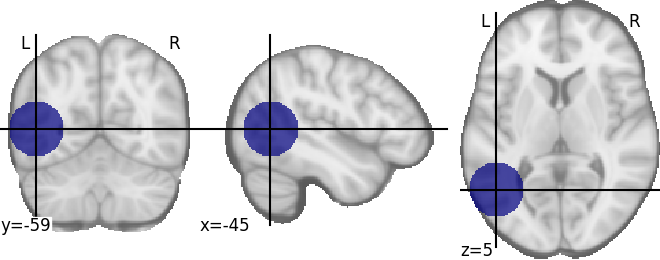Note
Click here to download the full example code
Defining a synthetic lesion¶
# # Defining a Lesion
# Conducting a lesion analysis in ConWhAt is extremely simple. All that is needed is a binary `.nii` format lesion mask, with ones indicating lesioned tissue, and zeros elsewhere.
#
#
# >(Note: we terms like 'lesion' and 'damage' throughout most of this documentation, as that is the most natural primary context for ConWhAt analyses. Remember however that all we are doing at the end of the day is doing a set of look-up operations between a list of standard space coordinates on the one hand (as defined by non-zero values in a `.nii` image), and the spatial locations of each 'connectome edge' - i.e. each entry in our anatomical connectivity matrix. One can envisave many alternative interpretations/applications of this procedure; for example to map the connectivity effects of magnetic field or current distributions from nonivasive brain stimulation). Still, for concreteness and simplicity, we stick with 'lesion', 'damage', etc. for the most part. )
#
#
# A common way to obtain a lesion map is to from a patient's T1-weighted MR image. Although this can be done manually, it is strongly recommended to use an automated lesion segmentation tools, followed by manual editing.
#
# An alternative way is simply to define a lesion location using standard space coordinates, and build a 'lesion' mask *de-novo*. This is what we do in the following example. On the next page we do a ConWhAt connectome-based decomposition analysis on this 'synthetic' lesion mask.
#
# ---
Setup¶
# ConWhAt stuff
from conwhat import VolConnAtlas,StreamConnAtlas,VolTractAtlas,StreamTractAtlas
from conwhat.viz.volume import plot_vol_and_rois_nilearn
# Neuroimaging stuff
import nibabel as nib
from nilearn.plotting import plot_roi
from nilearn.datasets import load_mni152_template
from nipy.labs.spatial_models.mroi import subdomain_from_balls
from nipy.labs.spatial_models.discrete_domain import grid_domain_from_image
# Viz stuff
from matplotlib import pyplot as plt
# Generic stuff
import os,sys,glob,numpy as np
# (For docs only: suppress warnings)
import warnings
warnings.filterwarnings("ignore")
# Define some variables
# Locate the standard space template image
t1_mni_url = 'https://github.com/Washington-University/HCPpipelines/raw/master/global/templates/MNI152_T1_1mm_brain.nii.gz'
os.system('wget ' + t1_mni_url)
t1_mni_file = t1_mni_url.split('/')[-1]
t1_mni_img = nib.load(t1_mni_file)
# This is the output we will save to file and use in the next example
lesion_file = 'synthetic_lesion_20mm_sphere_-46_-60_6.nii.gz'
# Define the 'synthetic lesion' location and size using standard (MNI) space coordinates
com = [-46,-60,6] # com = centre of mass
rad = 20 # radius
# Create the ROI
domain = grid_domain_from_image(t1_mni_img)
lesion_img = subdomain_from_balls(domain,np.array([com]), np.array([rad])).to_image()
# Plot on brain slices
disp = plot_roi(lesion_img,bg_img=t1_mni_img,black_bg=False);
# Save to file
lesion_img.to_filename(lesion_file)
# ...now we move on to doing a lesion analysis with this file.

Total running time of the script: ( 0 minutes 5.121 seconds)